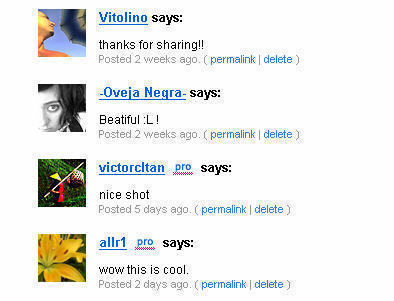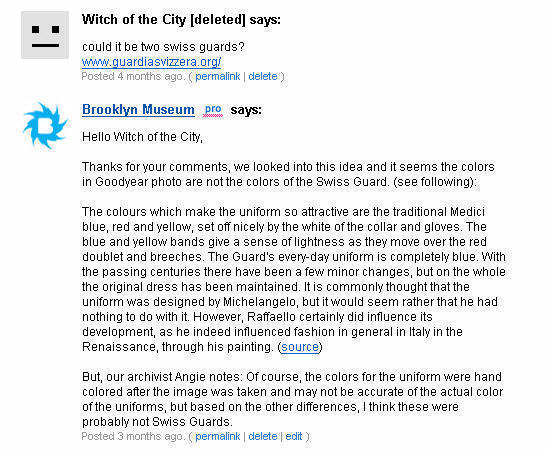Flickr Commons: Coping with a Small Staff and Community Ideals
One of the interesting things about The Commons is anyone can do it, which is pretty cool. Often, I think, larger institutions have an advantage over the smaller ones in that they get to put personnel behind coding projects to get their materials out the door. For a smaller institution, the coding barrier can be a difficult one—it makes projects expensive and often not doable. Here at Brooklyn, we fall somewhere in between—we are lucky to have a talented team of developers on staff, but it’s never enough for all the projects we’d like to do or to keep up with the demands of our existing infrastructure. As readers of this blog (or if you’ve ever seen me speak at conferences) already know, we will often try and find a Scrappy-Doo solution to get us through, which allows us to experiment before committing resources to major project or, sometimes, the scrappy solution enables us to do a project that we could otherwise never commit staff time to.

The Commons can help smaller institutions by eliminating the coding barrier. Flickr already has ways to upload and change data in batch and there’s a strong community of developers coding Grease Monkey scripts to help add functionality where Flickr stops—thank you Flickr, for a rockin’ API. While some members of The Commons created their own batch upload tools to draw directly from their internal systems, Brooklyn just used existing tools (Flickr’s Uploadr and Organizr paired with Steev’s GM scripts) and this worked well for us without the need of another big project, but it didn’t eliminate issues of workload—it just transferred them to another area.
As I mentioned in my last post, what was once a small town turned into a big, booming metropolis when we joined The Commons. Previously there had been a lot of discussion going on about the current happenings of the institution and those discussions were quick, easy and (most of all) fun exchanges. We could get back to people within 24 hours and really engage in a personal way—it was clear to everyone (we hope) that someone was home—that we were there to put a personal face on the institution and we took that very seriously.
We find the exchanges at The Commons are fundamentally different than what we had been experiencing and they tend to be more time consuming for us. This is high-traffic, so we exponentially increased exposure to all the materials on our account by a lot more than what we had been used to. Each time a new institution joins The Commons, the publicity from it drives more traffic our way. This issue doesn’t really go away—it just becomes an even greater challenge to manage our time. You might be asking at this point, don’t we all want higher traffic for our materials? What could possibly be the problem here and why could it possibly outweigh the benefit of more exposure?

True enough, we’ve seen a lot of fantastic things happen with the material because of this exposure, but we’ve also been grappling with the staff time it takes to respond to people in a meaningful way. For one, often people just tell us how much they really like something we’ve uploaded, and while that’s really nice, it creates a lot of filtering through those responses to ensure we don’t miss the questions people may have or the contributions they have to offer. For instance, I once missed a major contribution for way too long just because it got buried (ummm, yikes).
Also, it’s been more difficult to get to know this group of people on a personal level. This rolls round to the big, bustling city again. In the small town, we thrilled to see responses like the above because we knew (or were getting to know) the people who were leaving the comments. Now, it’s a bit overwhelming and I often feel as if we can’t engage the way we used to (there have been some exceptions here, but this is my general feeling).

Sometimes we see that visitors to The Commons will ask questions casually (example above) as a way of engaging, but it can provide us with a difficult task—meaningful responses take a decent amount of research and time.

When we get contributions that can lead us in the right direction and fill in a missing piece of the puzzle, we want to verify that before changing our own records and this verification process takes time. It’s pretty fantastic that we are getting this kind of response, but the verification takes enough time that I often feel it gives the impression there is a void of interaction on our account because we don’t respond as quickly as we’d like. The kind of response time shown above is an eternity on the www, but a reality for us given the amount of resources we have (read on…).

As we take this break to examine the cause and effect of all of this, we have to consider just how strapped we are for staff time. To give you an idea, we have one Archivist (Angie) who’s been working with a volunteer researcher (Ed, you are awesome) in order to maintain the account. I help by going through the incoming responses and manage things by sending things to Angie and Ed that need a response or those really whiz-bang cool things they will want to know about. Given that this needs to be less than 1/10 of what we do on a normal basis, keeping up can be a bit stressful for all of us. It’s ironic that smaller institutions can now take advantage of a system like this since it may create other problems when there are fewer people to share the workload (or, at least, this has been a challenge for us).
What’s interesting for me personally is that this equation—our presence on social networks, our e-comment books, the Posse, this blog, etc.—had never, ever presented a problem. It was always a very doable amount of time and always, always, always a very personal engagement, but the higher traffic at The Commons has somewhat tipped the balance in this one instance and it makes it an interesting case study.
The great news is the assets are being seen by a broader audience (another primary part of our mission), we are gaining a better understanding of how people are using our materials (something we really need to know) and we’ve seen a lot engagement (which can be really awesome), but in trying to maintain our own ideals in how we approach community on the web, we are cautious moving forward. In thinking about how to resume our uploads to The Commons, I have a feeling you’ll see fewer uploads overall at a much slower pace so we can keep up.
If you’ve made it this far…fun news is coming at the end of the week, so hope to see you then!

Shelley Bernstein is the former Vice Director of Digital Engagement & Technology at the Brooklyn Museum where she spearheaded digital projects with public participation at their center. In the most recent example—ASK Brooklyn Museum—visitors ask questions using their mobile devices and experts answer in real time. She organized three award-winning projects—Click! A Crowd-Curated Exhibition, Split Second: Indian Paintings, GO: a community-curated open studio project—which enabled the public to participate in the exhibition process.
Shelley was named one of the 40 Under 40 in Crain's New York Business and her work on the Museum's digital strategy has been featured in the New York Times.
In 2016, Shelley joined the staff at the Barnes Foundation as the Deputy Director of Digital Initiatives and Chief Experience Officer.
